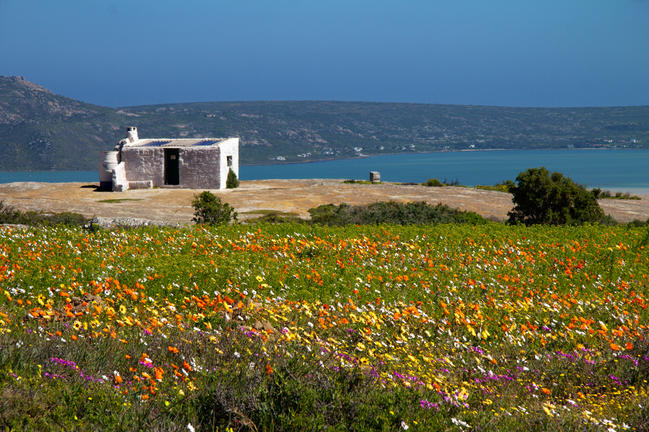Inland from Saldanha Bay, with the crashing waves of the Atlantic Ocean behind you, lies the West Coast National Park, with 3 distinct sections; Postberg, Langebaan, and Saldanha Bay, each with its own unique delights.
With the azure blue Langebaan Lagoon, the white dunes, unspoilt golden beaches, sheltered islands, rare fynbos, green wetlands, and salt marshes, this National Park has its own unique flavour. In fact, no other South African National Park has one quite like it. Best of all, it’s within easy driving distance from Cape Town. It’s a paradise, not only for the humans who enjoy mountain-biking, hiking, picnicking, kiteboarding and kayaking, but also birds like the migrant waders from the north. African Black Oystercatchers, the endangered Bank Cormorant, Kelp Gulls, African Jackass Penguins, and flamingoes are some of the 300 recorded bird species seen in the Park. For some of these birds, the Park is vital in terms of survival of their species.
Sixteen Mile Beach, Malgas, Jutten, Schaapen and Marcus Islands, all of which are a part of the Park have special protection status. Individually, they are as important as the Park itself. Cape Fur Seals have established a breeding colony on Vonderling Island, while European Rabbits thrive on Schaapen and Jutten islands. The most interesting population, an albino colony, is on Schaapen Island. During the hot dry summers, the fluffle grazes on seaweed.
The Langebaan Lagoon is a wetland of international importance because of its sensitive ecosystems as well as the surrounding land. These salt marshes provide much of the decaying plant matter that forms the basis of the estuarine food web feeding the prawns, bloodworms, crabs, snails, mussels, clams, and mullet fish.
Depending on the winter rains, the Park is covered in field upon field of bright, rainbow-coloured flowers during the months of Spring, September to December. Strolling through this stunning beauty, and in the unique Postberg section of the park are eland, red hartebeest, bontebok, kudu, gemsbok, steenbok, mountain zebra, duiker and ostriches. Not to mention bat-eared foxes, caracals, and families of Cape gray mongooses making game viewing an absolute delight. And quite different to the game viewing experiences in other South African Parks. Not many of the National Parks also include whale watching (August to November).
Here you can also walk in the footsteps of Eve, so to speak. The footprints of a young woman who lived in the area 117 000 years ago were discovered in 1995 at Kraalbaai. These footprints were originally made in sea sand by the young woman, which then hardened into rock. The original prints are housed at the Iziko Museums’ South African National Museum in Cape Town, but the replica can be viewed at the Geelbek Information Centre. Today, you can walk Eve's Trail, 30km though the wilderness over 2.5 days. Speaking of Geelbek…
Anyone looking for authentic cuisine, the Geelbek Restaurant, set in a beautifully restored 300-year-old Cape Dutch homestead, serves delicious dishes telling the story of the rich local history. The menu is influenced by the Portuguese, Dutch, Norwegian, Italian and Malay who all played a part in the chronicle of the area.

